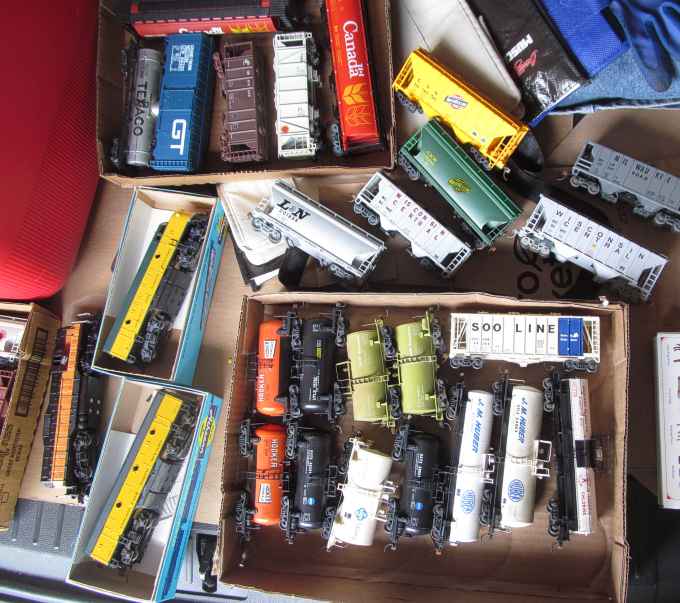|
There was an estate sale for a model rail collector in Wisconsin Rapids. I heard that he was part of the local club that had a public display in the old Rapids Mall on the west side of town (that mall was half torn down and changed greatly, over ten years ago.)
I bought almost 4 dozen rail cars, the price was good at $5 for cars and $20 or less for Athearn locomotives. |

 I think I saw some of this collection at an estate sale last year.
I think I saw some of this collection at an estate sale last year.
But back then, these items sold for 6 to $15 dollars each, so I didn't buy many last year.
They are sufficient cars, and I turned down a half dozen because I was familiar with how hard they can be to repair,
such as correcting the wheel gauge
(6 of the cars I got had wide gauge by over a sixteenth inch,
one was over a sixteenth under on all 4 axles),
or difficulty in maintaining the coupler pockets.
At least they all had real couplers, but some are the PLASTIC look-alikes to the good Kadees
and they don't always stay coupled when going down my hills.
The Great Northern covered hopper has a loose weight inside, it won't stay in the middle,
and I could shake the weight to the outside of the curves and call it good, but my rails have left and right curves.and the car tips over easily,
It will be hard to unglue the top of that car to repair that.
One is really heavy, like four I had last year, so I suspect there's some extra lead weight slabs glued inside, which they didn't need.
Sure it's nice to hear real metal wheels sing on the rails, but I can haul more regular cars up the hills if they aren't excessivly heavy.
To me, excess weight just enhances derailments. Weight in the correct location (down low) can prevent tip-overs.
|
I had always wanted one Canadian cylindrical hopper car with the wheat symbol. And here, I found 5 of them. And some Saskatchewan and Alberta wheat hoppers. And some 1983 Winnipeg NMRA model railroad convention cars. I was concerned about the quality of the trucks and wheels (afterwards I learned some are Bachmann) Nothng beats rolling a car down a slight ramp (I have a wood shim that matches a 2% grade). It's not good enough to just turn a car on its top and roll the wheels by my fingers to tell how free-rolling a car is. |

.
|
I got 4 Athearn locomotives, used, which had up to a thirty-second inch of crud stuck on the wheels, which I scraped off with a screwdriver, then I used my electric eraser (which wasn't agressive enough) and then liquid track cleaner and a wire brush. I found two loose axles, but at least they still have electrical pick up. I feel like I am operating the Milwaukee Road in it's final year, sending out trains with twice as many locomotives than normally needed, just to be sure there's enough so they can pull the load by the end of the day.
The cylindrical hoppers are 'different' than other hoppers. There round-ness is like a tank car. |

|
So, I got over two year's worth of used trains all from one place. As I said last year, I have to be more careful of what I buy to keep up my quality of operation. I bought the Canadian hoppers even though they are longer than I normally buy, and I had to trim some foot steps to clear the swing of the trucks so they go around my 18-inch radius HO scale track. I stuck to my commitment to buy 4-axle locomotives, so I can operate trains on my sub-standard 15-inch radius siding of my reversing loop. At least I'll keep someone else's dream of a railroad empire rolling along. |
to My Main Index Page on the TrainWeb site.
This page was made in June 2023